| Getting your Trinity Audio player ready… |
Here is one cycle that can be helpful in implementing new internet marketing strategy or upgrading the existing internet marketing strategy. Of course each business has distinct marketing requirements so might need variations accordingly. Hopefully this gives an idea for practicing online marketers or web agencies, as well as business who are looking to do internet marketing services.

Let’s see bits of details for each process:
Step 1: Keyword Research
Keyword research is the most important stage. If you get this incorrect, your overall strategy or the cycle would spiral aimlessly. Important factors to consider for Keyword Research are: the industry, keyword search volume, resources available (if you have more resources, you can target more or better keywords), keyword difficulty and some common sense. Tools such as Google Keyword Tool should give you a good idea to start. This is a set of keywords that apply to your overall marketing activities. Make sure you get it right early to stop losing money & resources for nothing.
Step 2: Website
Website is the heart of all marketing activities for e-commerce and also for all others that aim to use website as a channel for their business. A website should represent your business. A good website needs to consider its target users as well as search engines – not just the view of the owner! Make sure users can find what they come for as well as be pleased choosing your business.
Step 3: SEO (on page)
For a business, nothing is worse than having a great looking website that nobody knows about. If you have done the keyword research properly, you are in the right track. Else more backward to step 1 first. As most users still use search engines such as Google to find most of the stuffs online, you should know how to make a site that search engines can rank well. Search engines such as Google considers content of website as well as who is liking to them to rank it. As you make the website, make sure you make the adjustments on site to make it SEO friendly.
Step 4: Updates
One way communication is dead. You need to be alive, keep updated content and communicate with users. Blog is a great way to keep users updated. You need to write regularly. Again the guidelines on what to update goes back to keyword research of Step 1. Make sure you get them right. Having a blog that doesn’t update or doesn’t update related content is a turn-off and a resource hog. If you can’t find the resources to blog or keep users updated, blogging may not even for your business. You can integrate your news/blog with social media as well for better user experience.
Step 5: Social Media
Internet is not the one way communication as it used to be. With social sites, growing internet reach and ease of access through mobile devices, each consumer has the power to access & share information to worldwide users in real-time. You can no longer do waiting business. You need to be where your prospects are and communicate to them being yourself. Be creative & authentic so users can like you. There are growing number of social sites such as Facebook, Twitter, YouTube that are not only great for real-time communication for also for long term online branding.
Step 6: Email Marketing
Email marketing or permission marketing is another great way to reach to your prospects and consumers. Once you have a content strategy for website and social media, it is a good idea to reach to users using email. Email newsletters can also be a good way to send offers and updates to users directly to their inbox. Be sure you collect your user details through website or direct connection only.
Step 7: SEO (off page)
Search engines rank website based on content of website and recommendations on the Internet. Now that you have covered on-page SEO on Step 3, spend some time for getting good content that others can recommend. Link building can be a tedious and ongoing process that you should do to get visitors to your website through search or other channels. Again it helps if the keyword research has been done well. Make sure you follow genuine techniques to get links and be aware of search algorithm changes such as Google Panda or Penguin. If you are considering affiliate marketing, for example, make sure it follows the search engine guidelines.
Step 8: PPC Advertising
SEO is great but slow. If you need quick results, choose advertising. On the Internet, PPC or pay per click ads are a great way to do it, Google AdWords and Facebook Ads being the most popular ones. PPC advertising is also a great way to spread words about new brands. Whether you want to overlap PPC campaigns with your SEO keywords depends on your business requirement.
Like other life-cycles, internet marketing is a continuous process and should be integrated with overall marketing strategy of the business. The good thing about Internet marketing is that the results are more measurable than other forms of marketing. However, unlike other cycles, it does not necessarily go through same cycle every time after completion. For example, the on-site SEO or web usability parts will be needed less after the first cycle.
Leave a Reply